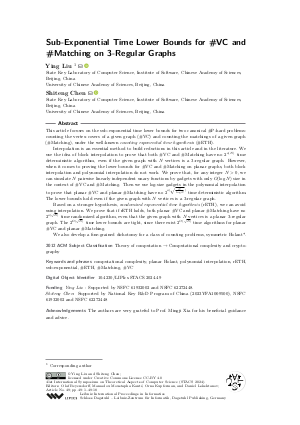LIPIcs.STACS.2024.49.pdf
- Filesize: 1.02 MB
- 18 pages

 Creative Commons Attribution 4.0 International license
Creative Commons Attribution 4.0 International license

This article focuses on the sub-exponential time lower bounds for two canonical #P-hard problems: counting the vertex covers of a given graph (#VC) and counting the matchings of a given graph (#Matching), under the well-known counting exponential time hypothesis (#ETH).
Interpolation is an essential method to build reductions in this article and in the literature. We use the idea of block interpolation to prove that both #VC and #Matching have no 2^{o(N)} time deterministic algorithm, even if the given graph with N vertices is a 3-regular graph. However, when it comes to proving the lower bounds for #VC and #Matching on planar graphs, both block interpolation and polynomial interpolation do not work. We prove that, for any integer N > 0, we can simulate N pairwise linearly independent unary functions by gadgets with only O(log N) size in the context of #VC and #Matching. Then we use log-size gadgets in the polynomial interpolation to prove that planar #VC and planar #Matching have no 2^{o(√{N/(log N)})} time deterministic algorithm. The lower bounds hold even if the given graph with N vertices is a 3-regular graph.
Based on a stronger hypothesis, randomized exponential time hypothesis (rETH), we can avoid using interpolation. We prove that if rETH holds, both planar #VC and planar #Matching have no 2^{o(√N)} time randomized algorithm, even that the given graph with N vertices is a planar 3-regular graph. The 2^{Ω(√N)} time lower bounds are tight, since there exist 2^{O(√N)} time algorithms for planar #VC and planar #Matching.
We also develop a fine-grained dichotomy for a class of counting problems, symmetric Holant*.











Feedback for Dagstuhl Publishing